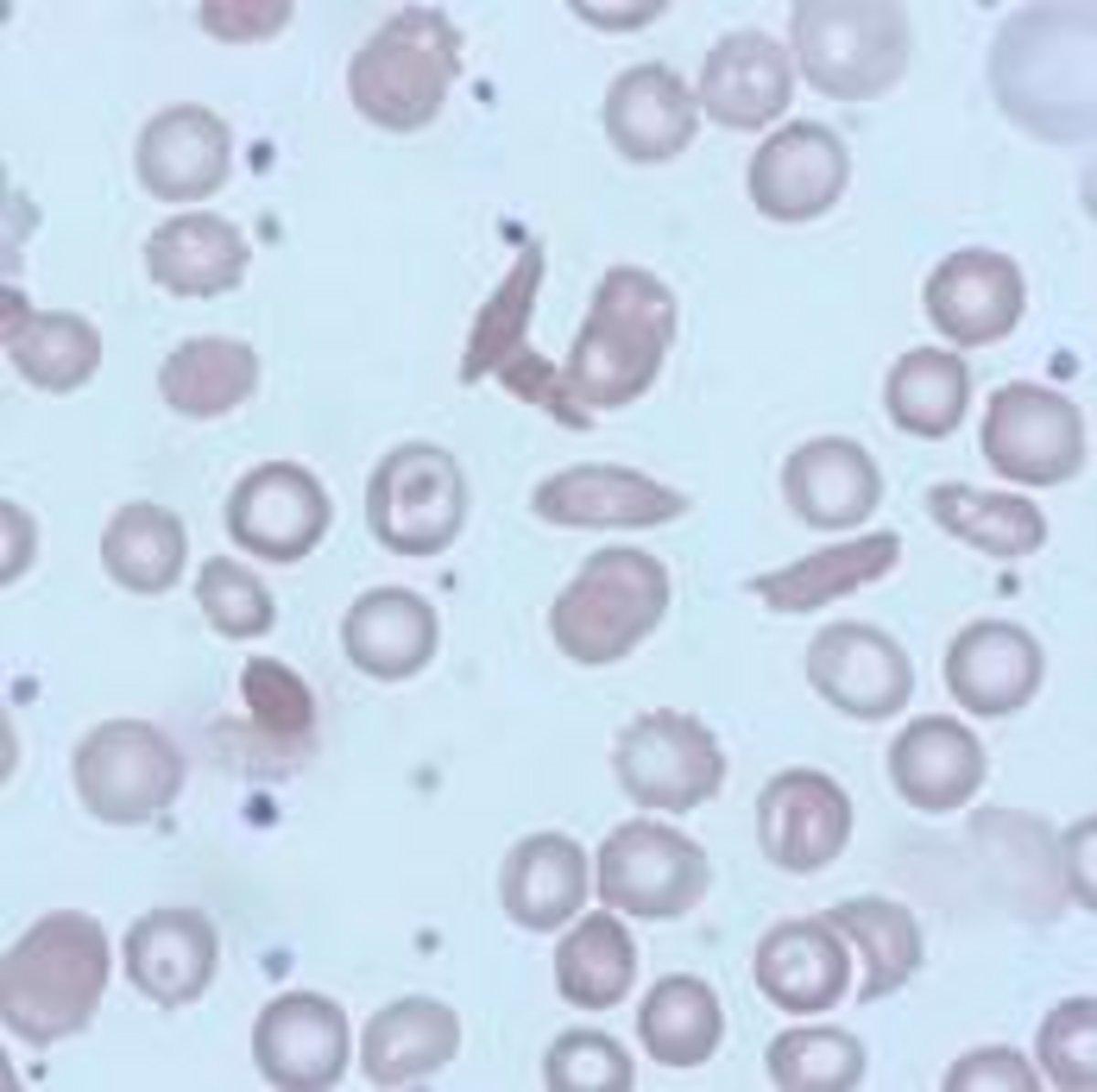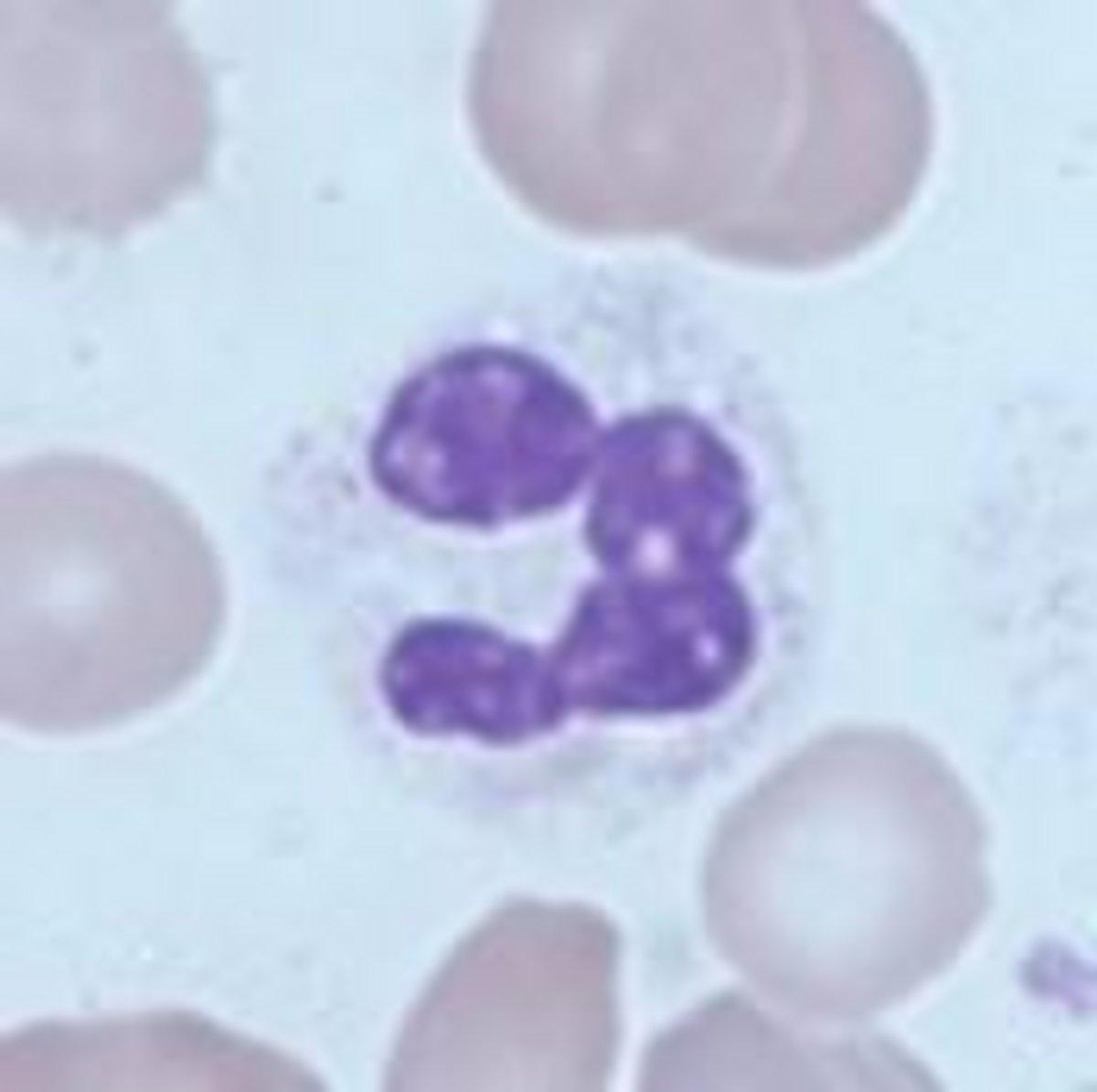

April 2023
Monthly Digital Case Study
April 2023 QSP Slides
Malaria
Quiz
(PDF for print)
April 2023 QSP Slide 3:
Slide 1
Slide 2
FBC Results | |||
| WBC | 11.20 (10^3/mm3) | Neutrophils | 35.6% |
| RBC | 2.72 (10^6/mm3) | Lymphocytes | 52.5% |
| HGB | 8.1 (g/dL) | Monocytes | 10.2% |
| HCT | 23.2 (%) | Eosinophils | 1.7% |
| MCV | 55 (fL) | Basophils | 0.0% |
| MCH | 29.8 (pg) | ||
| MCHC | 34.9 (g/dL) | ||
| PLT | 519 (10^3/mm3) | ||
| Retics | 568 (10^9/L) | ||
Clinical Details: Female, age not given.
Slide Information: Sickle cell anemia. Aniso-poikilocytosis (++). Sickle cells (++). Echinocytes (++). Hypochromic RBCs (see slide 1 above). Reticulocytosis (21%). To note: - The white blood cells seem +/- altered, - Apoptosis is clearly visible, especially on some images of polynuclear neutrophils (see slide 2). Presence of Echinocytes(++). The sample is very evocative of "old" blood. However, anemia and the sickle-shaped red blood cells indicate a requirement for hemoglobinopathy investigation (study of hemoglobin).
Continuing from the last issue, we will once again feature previously delivered content on malaria on the occasion of World Malaria Day in April.
The diagnosis of malaria is confirmed by blood tests which are either microscopic or non-microscopic tests.
Microscopic tests involve staining and direct visualisation of the parasite under the microscope. The direct microscopic visualisation of the parasite on the thick and/or thin blood smears has been the accepted method for the diagnosis of malaria in most settings, from the clinical laboratory to the field surveys, for over a hundred years. Careful examination of a well-prepared and well-stained blood film currently remains the “gold standard” for malaria diagnosis.
The full blood count is the first test to be carried out when malaria is suspected (and often when it is not). The full blood count will often give an indication as to the presence of malaria, usually a low platelet count is the first clue. When the parasites are present in the blood, they interfere with the counting on FBC instruments. This detection of these abnormalities can be used to generate flags to alert to the possible presence of the parasite.
HORIBA Medical developed a Malaria flag on several instruments: the Microsemi CRP LC-667G and ABX Pentra XL80, Pentra XLR from signals found in the WBC channels.
This technology was further developed in a later series of instruments, the Yumizen H500 and Yumizen H550 instruments, using machine learning techniques to create an S-score flag for P. Falciparum, P. Vivax, and Dengue (the latter is a mosquito-borne virus that produces symptoms that are similar to malaria).
High quality thick and thin films should be prepared and examined in every suspected case of malaria. A thick film should be used to detect presence of malaria parasites and the thin film for identification of species. It is useful to prepare four thick films and four thin films, so that two of each can be stained, leaving spare films to send to a reference centre and for further study, if there is diagnostic difficulty. Films should be made as soon as possible to avoid morphological alteration of parasites which occurs with storage of EDTA-anticoagulated blood. After collection of the blood sample, the film is stained with Romanowski stains to examine the intracellular appearance of the red cells.
Thin smears allow one to identify malaria species (including the diagnosis of mixed infections), quantify parasitaemia, and assess for the presence of schizonts, gametocytes, and malarial pigment in neutrophils and monocytes. Thin blood films stained by Giemsa’s or Leishman’s stain are useful for specification of parasites and for the stippling of infected red
cells. The optimal pH of the stain is 7.2.
A combination of thick and thin films for the detection of malaria is advised. A thin film alone could result in the parasites being missed if the parasitaemia is low. A thick film usually allows 6-20 layers of RBC’s, meaning a larger volume of blood can be examined. The recommended staining for thick films is Fields stain. This is composed of Fields stain A (buffered solution of Azure dye) and Fields stain B (a buffered solution of eosin). Due to the haemolysis and slow drying, the plasmodia morphology can get distorted, making differentiation of species difficult. Thick smears are therefore used to detect infection, and to estimate parasite concentration.
Malaria rapid diagnostic tests (RDTs) supplement the diagnosis of malaria by providing evidence of the presence of malaria parasites in blood. RDTs are used in addition to microscopy, particularly where good quality microscopy experience is not available. The test works by detecting specific antigens (proteins) produced by malaria parasites in the blood of infected individuals.
It is a lateral flow immuno-chromatographic antigen-detection tests, which works by capturing dye-labelled antibodies to produce a visible band on a strip of nitro-cellulose in a cassette casing. With malaria RDTs, the dye-labelled antibody first binds to a parasite antigen, and the resultant complex is captured on the strip by a band of bound antibody, forming a visible line (T - test line) in the results window. A control line (C- control line) gives information on the integrity of the antibody-dye conjugate, but does not confirm the ability to detect parasite antigen. Some kits can only detect one species (P. falciparum or P. vivax) while others detect multiple species (P. falciparum, P. vivax, P. malariae and P. ovale).
Bibliography
Essential Haematology, A.V .Hoffbrand & J.E.Pettit https://www.ncbi.nlm.nih.gov/books/NBK555962/
Do you have any questions or requests? Use this form to contact our specialists.


